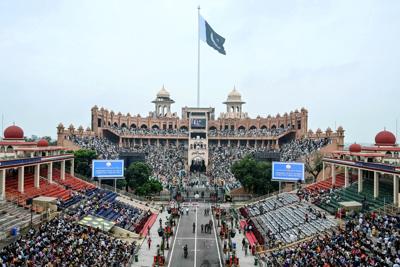In 2010, my parents planned an ambitious cross-India trip to visit not only major tourist sites like the Taj Mahal, but their own ancestral homes: my fatherŌĆÖs in Hyderabad in the south, and my motherŌĆÖs in Nehtaur in the north.┬Ā
I knew this would be a trip of a lifetime. The visa requirements had extra hurdles for those, like me, who were born in Pakistan. As a Canadian, I was spoiled with passport privilege, so this was quite discouraging. That was the point.
It was still then possible with some persistence for Pakistanis to visit India, especially those living abroad, and my parents managed to secure theirs. I ran out of time, and figured there would be future opportunities to make the trip to India.┬Ā
But since then, the border between India and Pakistan has hardened ŌĆö more so after this springŌĆÖs conflict following the Pahalgam attack in Kashmir, of those who waited up to a decade for permission. Now, I imagine itŌĆÖs nearly impossible for me to get that visa without a special invitation.
PartitionŌĆÖs 78th anniversary just passed, and the border between India and Pakistan has not only has calcified over time; it has also managed to cleave how we imagine our histories in unnatural ways, divorcing centuries of shared culture, history and language. For those in the diaspora who are the descendants of the 15 million who migrated after these countries became independent from the British, it has created a double displacement ŌĆö the sense that you can never, truly, go home.
The borders drawn up by British lawyer Cyril Radcliffe in 1947 ŌĆö who had five weeks to complete this task and had previously not been east of Paris ŌĆö determined new citizenships for 400 million people across India and Pakistan, and what would eventually become Bangladesh.┬Ā
Outside the subcontinent, saying you are Indian, Pakistani or Bangladeshi is assumed to be uncomplicated, a way to locate what type of brown person you are. IŌĆÖve resisted this need to slot immigrants into convenient boxes by looking closely at not only my family history, but many personal stories.┬Ā
These narratives provide colour and shade to the broad strokes of history, allowing me to understand how my family has been shaped by multiple migrations, and why thereŌĆÖs no singular culture I can refer to explain my roots.
I never gave deep thought to how Partition shaped both my families, until I started writing a book about my paternal grandmother, who was 25 at the time of independence. My youngest uncle prompted a shift in perspective when he said something that struck me during an interview: ŌĆ£We were refugees.ŌĆØ
I realized then my understanding of Partition had been limited ŌĆö as something that happened in August 1947, not something that unfolded over a decade. My fatherŌĆÖs family made the final move from India to Pakistan in 1956, and I finally saw this wasnŌĆÖt a belated consequence of Partition, but rather, part of its story.
Partition was the largest mass migration of the 20th century, and the resulting violence left an estimated one to two million dead. ŌĆ£Even by the standards of the violent twentieth century, the Partition of India is remembered for its carnage,ŌĆØ writes Yasmine Khan in her seminal book on the subject, The Great Partition. ŌĆ£It seems that the aim was not only to kill, but to break people.ŌĆØ
The violence also endured beyond 1947. My mother, born in Pakistan post-Partition, recently told me about her familyŌĆÖs departure from their small town in Uttar Pradesh in 1948. It was prompted by her cousin stepping out of a taxi, only for his shoe to sink into a pool of blood ŌĆö a frightening reminder of the ongoing communal conflict. Terrified of the continued strife, he begged his mother to leave, who refused until her brother ŌĆö my grandfather ŌĆö agreed to move with them.┬Ā
An extended exploratory visit to Karachi in 1951 caused my paternal grandfatherŌĆÖs home in Hyderabad to be usurped by the new state, as empty homes on both sides of the border were assumed to be abandoned, and being given to new arrivals. His was one of many court cases filed at the time reclaiming property, made easier in his case because no one had occupied it before his return.┬Ā
It was that home the family finally left in 1956.My father only returned once more, in 1983, finding his childhood home that once used to be on the outskirts of the city, now part of urban sprawl. By 2010, his ancestral graveyard had been built over and he could no longer find the home, seemingly swallowed by the ever-growing city.
My connection to India itself would have been swallowed up by the false narrative of how separate the nations appear to be today, had I not started to ask questions about how my family experienced this seismic historical event. While there are volumes of literature on Partition, there is something about locating myself in history that became the starting point of mapping out both the larger story of Partition, and the details within it that impacted ordinary people, that have started to unravel my once-limited understanding of the past.
As we are losing the last generation who have firsthand accounts, itŌĆÖs been heartening to see a wave of efforts to capture them, so that the nuanced history of South Asia isnŌĆÖt overshadowed by simplistic binaries. , an Instagram account and Substack run by Brampton-based Ahsun Zafar, has covered everything from the tattoos of Partition to how one familyŌĆÖs cuisine changed as a result of migration. Indian historian Aanchal MalhotraŌĆÖs work focuses on oral histories and archive objects, for instance, examining the stories behind 21 objects carried across the border . She also co-founded the , a digital repository of items from 1970 and earlier collected from the subcontinent. The Citizen Archive of Pakistan has an and has collected more than 5,000 accounts of everything from pre-Partition life, to Partition itself and early days of the country.┬Ā
And then thereŌĆÖs my favourite genre, the family memoir. I was floored by author and journalist Mishal HusainŌĆÖs book , a detailed political retelling of the events that led to Partition and also insight into two familiesŌĆÖ everyday lives during that era. One passage in particular from her paternal grandfather, who grew up in Multan, stayed with me. ŌĆ£Our homeland speaks to our most intimate memories, moves our deepest emotions,ŌĆØ Husain quotes from her grandfatherŌĆÖs memoir. ŌĆ£Everything that is part of it belongs to us in some measure. And in a way we belong to it too, as a leaf belongs to a tree.ŌĆØ┬Ā
When the conflict broke out between Pakistan and India this spring, I shared on Instagram how much I learned from the vivid portraits of Partition by writer Saadat Hasan Manto, who despite longing to stay in India, eventually moved to Pakistan, but was never quite being able to separate the two as cleanly as the line on the map was drawn.┬Ā
I wrote that I hoped to visit one day, to see where my paternal grandmother was born in Ambehta, where my maternal grandfather lived in Nehtaur, where my father played as a child in Hyderabad. And then hope appeared in friendship ŌĆö an Indian friend IŌĆÖve grown close with in London responded: ŌĆ£We’ll get you to India one day.ŌĆØ
Error! Sorry, there was an error processing your request.
There was a problem with the recaptcha. Please try again.
You may unsubscribe at any time. By signing up, you agree to our and . This site is protected by reCAPTCHA and the Google and apply.
Want more of the latest from us? Sign up for more at our newsletter page.



























To join the conversation set a first and last name in your user profile.
Sign in or register for free to join the Conversation